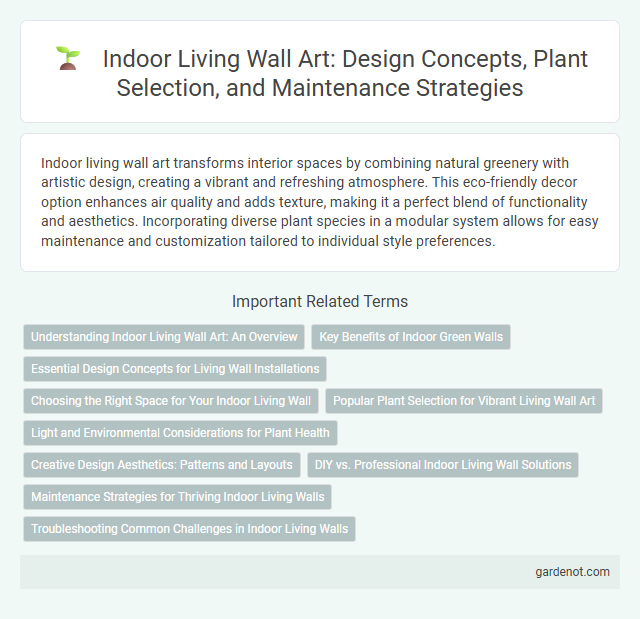Indoor living wall art transforms interior spaces by combining natural greenery with artistic design, creating a vibrant and refreshing atmosphere. This eco-friendly decor option enhances air quality and adds texture, making it a perfect blend of functionality and aesthetics. Incorporating diverse plant species in a modular system allows for easy maintenance and customization tailored to individual style preferences.
Understanding Indoor Living Wall Art: An Overview
Indoor living wall art transforms interior spaces by integrating lush, vertical greenery that enhances air quality and aesthetic appeal. These installations use a variety of plants suited for low-light environments, supported by smart irrigation systems that ensure optimal hydration and growth. Emphasizing biophilic design principles, indoor living walls contribute to wellness and productivity by bringing nature into urban, indoor settings.
Key Benefits of Indoor Green Walls
Indoor living wall art significantly improves air quality by naturally filtering pollutants and increasing oxygen levels. These green walls also enhance acoustic insulation, reducing noise pollution in enclosed spaces. Moreover, they boost mental well-being by providing biophilic design elements that reduce stress and improve focus.
Essential Design Concepts for Living Wall Installations
Indoor living wall art enhances interior aesthetics while improving air quality through natural vegetation. Essential design concepts for living wall installations include selecting appropriate plant species based on light availability, ensuring proper irrigation systems, and using lightweight, breathable substrates to support healthy root growth. Integrating modular panels allows for easy maintenance and customization, maximizing both visual impact and functionality in indoor spaces.
Choosing the Right Space for Your Indoor Living Wall
Selecting the ideal location for your indoor living wall is crucial to ensure optimal plant health and aesthetic appeal. Spaces with natural light exposure, such as near windows or under skylights, provide the necessary energy for photosynthesis, while areas with good air circulation prevent mold and mildew growth. Avoid placing living walls in high-traffic zones or locations prone to temperature fluctuations to maintain longevity and vibrant greenery.
Popular Plant Selection for Vibrant Living Wall Art
Ferns, pothos, and philodendrons are popular plant selections for vibrant indoor living wall art due to their adaptability to low light and diverse textures. Succulents and air plants add unique shapes and require minimal maintenance, ensuring long-lasting visual appeal. Incorporating flowering plants like orchids or begonias enhances color variety and dynamic vibrancy in living wall designs.
Light and Environmental Considerations for Plant Health
Indoor living wall art requires careful light management to ensure optimal photosynthesis and plant vitality, with full-spectrum LED lights often recommended to mimic natural sunlight. Environmental factors such as humidity levels and air circulation play a crucial role in preventing fungal growth and promoting healthy root development. Integrating smart sensors to monitor light intensity and moisture can enhance the longevity and aesthetic appeal of the living wall.
Creative Design Aesthetics: Patterns and Layouts
Indoor living wall art transforms spaces by integrating lush greenery with innovative patterns and layouts, enhancing both aesthetics and air quality. Creative design aesthetics emphasize geometric arrangements, asymmetrical compositions, and layered textures to create dynamic visual interest and depth. These living walls serve as functional art installations, blending natural elements with modern interiors for a harmonious and inspiring environment.
DIY vs. Professional Indoor Living Wall Solutions
Indoor living wall art enhances interior spaces by bringing natural elements indoors, offering air purification and aesthetic appeal. DIY indoor living wall solutions provide cost-effective customization through modular panels, but require careful plant selection and maintenance knowledge to ensure longevity. Professional indoor living wall services deliver expertly designed installations with integrated irrigation and lighting systems, guaranteeing optimal plant health and tailored design for various indoor environments.
Maintenance Strategies for Thriving Indoor Living Walls
Indoor living wall art flourishes with consistent maintenance strategies such as regular watering schedules, appropriate lighting conditions, and nutrient-rich soil management tailored to plant species. Integrating automated irrigation systems and using humidity controls help optimize environment factors critical for plant health and growth. Routine inspections for pests and diseases, coupled with periodic pruning, ensure longevity and vibrant aesthetic appeal.
Troubleshooting Common Challenges in Indoor Living Walls
Indoor living wall art often encounters issues such as uneven plant growth, which can result from inadequate lighting or inconsistent watering schedules, negatively affecting the overall aesthetic. Addressing root rot through proper drainage systems and selecting moisture-tolerant plant species helps maintain plant health and longevity. Regular monitoring for pests like spider mites and adapting humidity levels are critical for preventing infestations and sustaining vibrant indoor living walls.
Indoor living wall art Infographic

 gardenot.com
gardenot.com